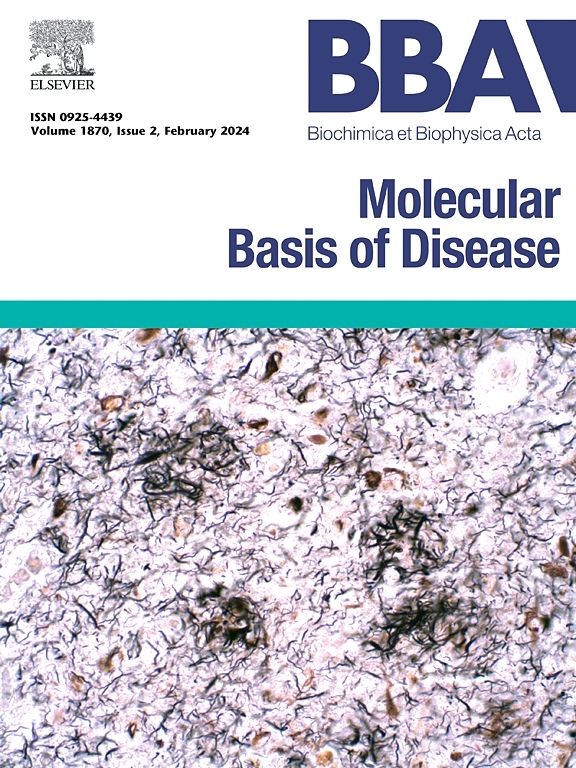The improvement in diagnostic yield of developmental and epileptic encephalopathy by the multi-omics sequential testing method
IF 4.2
2区 生物学
Q2 BIOCHEMISTRY & MOLECULAR BIOLOGY
Biochimica et biophysica acta. Molecular basis of disease
Pub Date : 2025-04-18
DOI:10.1016/j.bbadis.2025.167854
引用次数: 0
Abstract
Despite traditional panel and Whole Exome Sequencing (WES) assays, the causative factors for 60 % of epilepsy cases remain elusive, mainly due to incomplete detection of variant spectrums, and limited ability to interpret variants. Our research developed the multi-omics method of a comprehensive sequential testing methodology, to enhance the diagnostic yield for the etiology. In this study, we performed sequential multi-omics analyses on a cohort of 236 Chinese patients exhibiting recurrent seizures along with developmental delay or intellectual disability. Our study had devised a comprehensive multi-omics variant analysis methodology in a sequential mode. The initial analytical strategy included WES, CNV-seq and in-house cases evidence. If no pathogenic cause was identified, the subsequent analytical approach in the sequential mode included the analysis of WGS SVs, mitochondrial variations, dynamic mutations, and abnormalities in RNA-seq. Our results revealed that the initial step achieved a diagnostic detection rate of 44.1 % (104 cases). Subsequently, WGS and RNA-seq testing were performed, with 33 familial diagnoses tested positive, representing a 14 % increase. Meanwhile our pipeline has elucidated the pathogenicity classification of 72 variants which are either not yet recorded in the ClinVar database or are classified as VUS. Our study achieved an overall positive diagnostic rate of 58.1 % (137/236). In summary, our pipeline can detect comprehensive variant spectrums and provide a clear interpretation of variations with unclear clinical significance, the multi-omics sequential testing approach significantly improves the rate of genetic diagnosis for epileptic disorders.

多组学序列检测方法对发展性和癫痫性脑病诊断率的提高
尽管采用了传统的面板和全外显子组测序(WES)方法,但60%的癫痫病例的致病因素仍然难以捉摸,这主要是由于变异谱检测不完全,以及变异解释能力有限。我们的研究开发了一种综合序列检测方法的多组学方法,以提高病因的诊断率。在这项研究中,我们对236例伴有发育迟缓或智力残疾的反复发作的中国患者进行了序列多组学分析。我们的研究在序列模式下设计了一个全面的多组学变异分析方法。最初的分析策略包括WES、CNV-seq和内部病例证据。如果没有确定致病原因,接下来的序列分析方法包括分析WGS sv、线粒体变异、动态突变和RNA-seq异常。我们的结果显示,第一步达到了44.1%的诊断检出率(104例)。随后,进行了WGS和RNA-seq检测,有33例家族性诊断呈阳性,增加了14%。同时,我们已经阐明了72个变异的致病性分类,这些变异要么没有记录在ClinVar数据库中,要么被归类为VUS。我们的研究获得了58.1%(137/236)的总阳性诊断率。综上所述,我们的产品线可以检测全面的变异谱,并为临床意义不明确的变异提供清晰的解释,多组学序列检测方法显著提高了癫痫疾病的遗传诊断率。
本文章由计算机程序翻译,如有差异,请以英文原文为准。
求助全文
约1分钟内获得全文
求助全文
来源期刊
CiteScore
12.30
自引率
0.00%
发文量
218
审稿时长
32 days
期刊介绍:
BBA Molecular Basis of Disease addresses the biochemistry and molecular genetics of disease processes and models of human disease. This journal covers aspects of aging, cancer, metabolic-, neurological-, and immunological-based disease. Manuscripts focused on using animal models to elucidate biochemical and mechanistic insight in each of these conditions, are particularly encouraged. Manuscripts should emphasize the underlying mechanisms of disease pathways and provide novel contributions to the understanding and/or treatment of these disorders. Highly descriptive and method development submissions may be declined without full review. The submission of uninvited reviews to BBA - Molecular Basis of Disease is strongly discouraged, and any such uninvited review should be accompanied by a coverletter outlining the compelling reasons why the review should be considered.

 求助内容:
求助内容: 应助结果提醒方式:
应助结果提醒方式:


